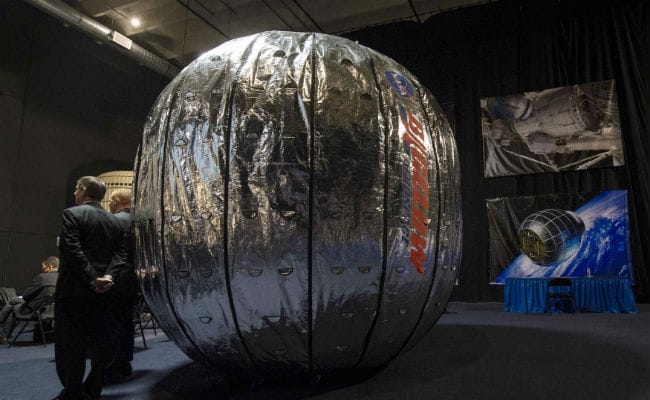
NASA astronaut Jeff Williams works inside the Bigelow Expandable Activity Module (BEAM) attached to the International Space Station. (Reuters photo)
Washington, United States:
Astronauts entered an inflatable add-on room at the International Space Station (ISS) on Monday for the first time since it was fully installed last month, NASA said.
US astronaut Jeff Williams told the US space agency's mission control that the flexible habitat -- known as the Bigelow Expandable Activity Module (BEAM) -- looked "pristine" and was cold inside after entering for the first in a two-year series of tests, NASA said in a statement.
NASA is testing expandable habitats astronauts might use on the Moon or Mars in the coming decades.
Williams opened the module's door at 4:47 US East Coast time (0847 GMT) before entering with Russian cosmonaut Oleg Skripochka to take an air sample, start collecting data from sensors and check air ducts.
"First steps into #BEAM will expand the frontiers of habitats for space," the ISS tweeted before Monday's operation.
They will close the door to the module, which first docked at the ISS in April, after each visit.
Astronauts are expected to re-enter the module several times a year throughout the two-year technology demonstration to retrieve sensor data and assess conditions inside the unit, including how well it protects against space radiation, the US space agency said.
Bigelow Aerospace developed the first-of-its-kind habitat as part of an $18 million contract with NASA.
 Williams successfully expanded BEAM on May 28 by releasing blasts of air into the pod's walls two days after aborting the first attempt when it ran into problems.
Williams successfully expanded BEAM on May 28 by releasing blasts of air into the pod's walls two days after aborting the first attempt when it ran into problems.
Weighing 1.4 tonnes, the module is 13 feet long (four meters) by 10.5 feet (3.23 meters) wide fully expanded.
The benefit of expandable habitats lies in the little space they take up in spacecrafts' cargo holds while providing greater living and working space once inflated.
But key questions that remain to be answered include how well such pods would protect people against solar radiation, debris and the temperature extremes of space.
US astronaut Jeff Williams told the US space agency's mission control that the flexible habitat -- known as the Bigelow Expandable Activity Module (BEAM) -- looked "pristine" and was cold inside after entering for the first in a two-year series of tests, NASA said in a statement.
NASA is testing expandable habitats astronauts might use on the Moon or Mars in the coming decades.
Williams opened the module's door at 4:47 US East Coast time (0847 GMT) before entering with Russian cosmonaut Oleg Skripochka to take an air sample, start collecting data from sensors and check air ducts.
"First steps into #BEAM will expand the frontiers of habitats for space," the ISS tweeted before Monday's operation.
Astronauts will enter the module again on Tuesday and Wednesday to test sensors and equipment, NASA said.First steps into #BEAM will expand the frontiers of habitats for space @BigelowSpace https://t.co/wjG5sxlamC pic.twitter.com/wyvgTY4HlP
- Intl. Space Station (@Space_Station) June 3, 2016
They will close the door to the module, which first docked at the ISS in April, after each visit.
Astronauts are expected to re-enter the module several times a year throughout the two-year technology demonstration to retrieve sensor data and assess conditions inside the unit, including how well it protects against space radiation, the US space agency said.
Bigelow Aerospace developed the first-of-its-kind habitat as part of an $18 million contract with NASA.

The Bigelow Expandable Activity Module (BEAM) is seen during a media briefing at Bigelow Aerospace in Las Vegas, Nevada, January 16, 2013. (Reuters photo)
Weighing 1.4 tonnes, the module is 13 feet long (four meters) by 10.5 feet (3.23 meters) wide fully expanded.
The benefit of expandable habitats lies in the little space they take up in spacecrafts' cargo holds while providing greater living and working space once inflated.
But key questions that remain to be answered include how well such pods would protect people against solar radiation, debris and the temperature extremes of space.
Track Latest News Live on NDTV.com and get news updates from India and around the world

